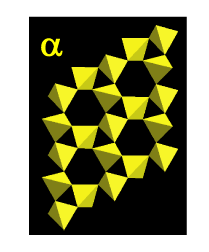
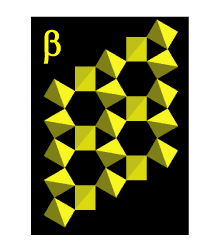
LOCAL STRUCTURE CHANGES IN QUARTZ THROUGH THE a-b PHASE TRANSITION
 |
On cooling the hexagonal high-temperature b-phase of quartz through the b-a phase transition at TC=846K, rotations of the SiO4 tetrahedra occur about <100> directions to form the trigonal low-temperature a-phase. This is the well studied and well documented behaviour of the average structure of quartz at high temperature. The phase transition is accompanied by a large increase in cell volume with increased temperature just below TC and substantial atomic displacement parameters in the b-phase. |
 |
The outstanding issue which gives rise to controversy concerns the nature of the phase transition and hence the origin of the large atomic displacement parameters in the b-phase. Some have argued that the b-phase is composed of a collection of domains of lower symmetry, which give rise to the apparent disorder in the average structure. Others argue for an order-disorder type phase transition, whereby phonon softening induces the phase transition and the disorder in the high-temperature b-phase is dynamic in origin.
The problem is that the average structure, as deduced from the elastic Bragg scattering, cannot directly distinguish between these two interpretations. We have therefore used neutron total scattering to measure the Bragg scattering and the diffuse scattering simultaneously as a function of temperature through the phase transition [1,2]. The total scattering when Fourier transformed gives the instantaneous atom pair correlation functions which give direct information on the local instantaneous structure.
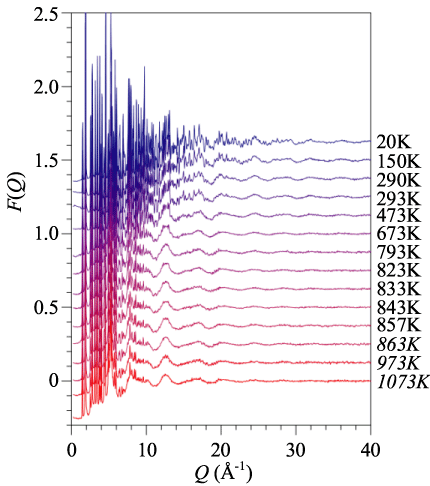 |
 |
In the above data, measured on LAD at ISIS, there is no clear evidence for the phase transition in the total scattering, which here occurs between the data at 857K and 863K; there is a continuous decrease in high-Q Bragg peak intensities and an increase in pronounced diffuse features with increasing temperature. This is reflected in the D(r), where the expansion of the Si-O and O-O distances with temperature are linear and do not change significantly at TC and in contrast to the bond lengths observed from the average structural models [3]. However, the macroscopic volume change is observed in the behaviour of the correlations at higher distances.
By modelling the data using the reverse Monte Carlo method, three-dimensional configurations have been produced which are consistent with the total scattering, the Bragg intensities and the known local tetrahedral environment [4]. These models give a complete picture of the structure of quartz and show that there are clear changes of symmetry at TC at the local level (see the behaviour of the the Si-Si-Si bond angle at a function of temperature below).
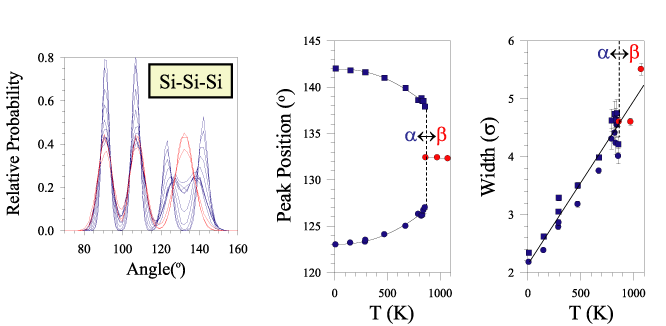 |
Interpretations of the disorder of b-quartz based on domains are therefore inappropriate. Additionally, the models reproduce the diffuse scattering maps obtained from neutron diffraction from a single crystal of quartz, further confirming the rigid unit mode picture of the behaviour of quartz [5].
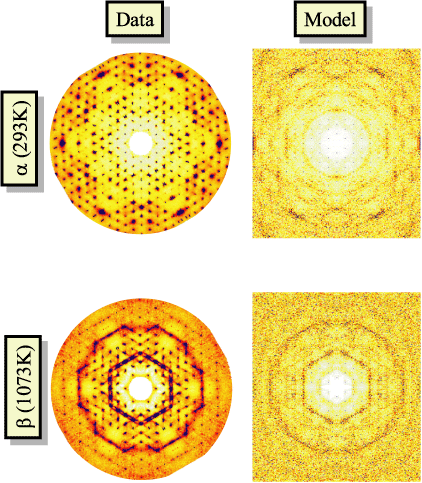 |
References.
| 1. | A detailed structural characterization of quartz on heating through the alpha-beta phase transition | M. G. Tucker, D. A. Keen and M. T. Dove | Miner. Mag. 65 (2001) 489-507 |
| 2. | Simultaneous analysis of changes in long-range and short-range structural order at the displacive phase transition in quartz | M. G. Tucker, M. T. Dove and D. A. Keen | J. Phys.: Condensed Matter 12 (2000) L723-30 |
| 3. | Direct measurement of the thermal expansion of the Si-O bond by neutron total scattering | M. G. Tucker, M. T. Dove and D. A. Keen | J. Phys.: Condensed Matter 12 (2000) L425-30 |
| 4. | Application of the reverse Monte Carlo method to crystalline materials | M. G. Tucker, M. T. Dove and D. A. Keen | J. Appl. Cryst. 34 (2001) 630-8 |
| 5. | Rigid Unit Modes in framework structures: theory, experiment and applications | M. T. Dove, K. O. Trachenko, M. G. Tucker and D. A. Keen | Reviews in Mineralogy 39 (2000) 1-33 |
|
|